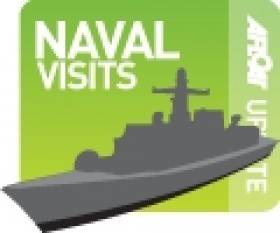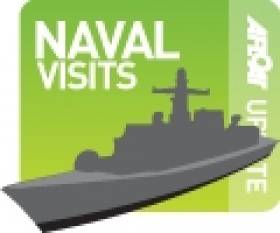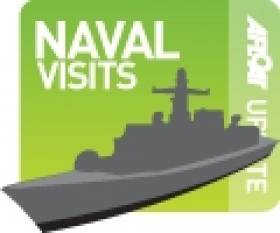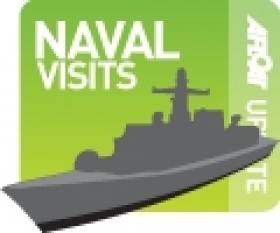Displaying items by tag: Naval Visits
Duke Class Frigate HMS Somerset to Make Visit
#RoyalNavy – HMS Somerset (F82) a Royal Navy Type 23 Duke Class frigate of 4,900 displacement tonnes is due to make a courtesy call to Dublin Port over the weekend, writes Jehan Ashmore.
The frigate is due to arrive early Saturday morning with her 184 strong –crew. She is one of a batch of Type 23 class frigates ordered in 1992 from the Yarrow yard in Scotstoun from where she was launched two years later.
The frigates are the core of the front-line fleet and HMS Somerset is based in her homeport of Devonport. As previously reported a sister HMS Richmond (F239) in March also made a call to the capital and more recently the rare visit of HMS Illustrious (RO6) in late April.
Former WW2 French Schooner to Visit on Bloomsday
#WW2schooner -A World War 2 schooner the Étoile (A649) now a French Navy Paimpolaise class cadet trainee vessel is due to make a call to Dublin Port on 'Bloomsday', writes Jehan Ashmore.
The near 81 year-old schooner or 'Goélettes' was launched in July 1932 at the Normandy shipyard of Chantiers Navals in Fécamp. She saw enemy action along with sister Belle-Poule (A650) having joined the Free French Forces.
In recognition of the pairs service during the war the schooners have the honour of flying the French flag with the cross of Lorraine.
The 275 tonnes schooner has a sail area of 450 m² and is also powered by a diesel motor. An officer has command of the 37m vessel and 15 crew.
#BattleofAtlantic – The Mersey will yet again be witness in marking another historic occasion tomorrow as the Battle of The Atlantic (on it 70th anniversary) is to be commemorated for the final time in the UK, writes Jehan Ashmore.
A unique opportunity to take part in the final ceremony is by taking a farewell cruise, as naval vessels from countries throughout Europe, Russia, US and Canada are to depart Liverpool. The event has also been commemorated in London and Derry-Londonderry.
The international flotilla which has spent the last few days in Liverpool represent both sides of the conflict which ran the entire length of the Second World War, from 1939 to 1945. The Battle of the Atlantic was pivotal to the success of the allied side, though the loss of life was horrific on both sides as highlighted on the Royal Navy BOA70 commemorative website.
Among the commemorative naval flotilla is HMS Edinburgh (D97) the last Type 42 destroyer in the Royal Navy fleet which is to decommission in Portsmouth in early June. It is apt her visit to Merseyside as she was launched in 1983 across the river on the Wirral Peninsula at the Cammell Laird shipyard.
#BattleofAtlantic- For five days, Liverpool is to host the 70th and final UK anniversary commemoration of the Battle of the Atlantic between Friday 24 to Tuesday 28 May.
In total there are 25 naval ships calling at the Liverpool Cruise Terminal and at Albert and Canning Docks, with several of these vessels made open to visitors. Naval vessels from the UK, Canada, Germany, Italy, Russia and the US will represent both sides of the conflict which ran the entire length of the Second World War, from 1939 to 1945.
On the final day of the event, Tuesday 28 May, all visiting ships will depart in a coordinated parade on the Mersey. To take part in the maritime spectacle, Mersey Ferries will be joining the flotilla and will follow the ships as they head out of the Mersey. On board the excursion cruise, a Blue Badge Guide will provide live commentary.
Mersey Ferries are to provide two ferries for the Farewell Cruise. The following are departure times for the farewell cruises are as follows: Departing Liverpool at 1.00pm and the other cruises are scheduled to depart Seacombe also 1.00pm and from Woodside at 1.15pm.
Ticket price for the Farewell Cruise are £25.00 per person. Each cruise is approximately 3-4 hours (duration time may vary).
In addition Mersey Ferries are to offer guaranteed parking spaces at both Seacombe and Woodside with a charge of £5.00 per car (noting spaces are limited).
For further details and how to book online visit: www.merseyferries.co.uk/content/Cruises/Cruisedates.aspx
#AircraftCarrier – During the rare visit of the Royal Navy's HMS Illustrious (R06) to Dublin Port (PHOTO's) at the weekend, the last serving 'Invincible' class aircraft-carrier was given a Gathering welcome with a showering of green light, writes Jehan Ashmore.
The 22,000 displacement tons former aircraft-carrier which currently serves in the role as a High Readiness Helicopter and Commando Carrier, had called to the capital having completed Exercise Joint Warrior, a multi-national event involving several navies, off the coast of Scotland.
The 35 year old vessel which berthed at Alexandra Basin, was floodlit in green (as it happens, aptly on her starboard side) from lamps laid alongside Ocean Pier.
The special lighting effects were created by the Worshipful Company of Lightmongers with whom 'Lusty' as she is affectionately known by her 700 crew have a close affiliation to.
Niall Gibbons, CEO Tourism Ireland, said: "We were delighted to welcome HMS Illustrious to Ireland and are sure that the sailors on board received a wonderful Irish welcome during their stay."
During her visit, two members of the Ship's Company, Able Seaman Andrew Liston, 25, from Chesterfield and Able Seaman Aaron Canwell, 31, from Wembley, were both awarded certificates of Irish Heritage for having family ties to the country.
Another highlight of their 'Gathering' visit was a performance by Irish group, Ragus, who transformed the ship's hangar into a stage filled with traditional Irish music and dance.
HMS Illustrious was launched in 1978 from Swan Hunter on the Tyne and for most of her career spanning more than three decades the 209m long vessel had on board the famous 'Harrier' VSTOL jump-jets aircraft.
The Portsmouth based vessel is one of four Royal Navy core amphibious vessels, however she is due to pay off in 2014 and in her place are a pair of Queen Elizabeth class 65,000 tons aircraft –carriers currently under construction.
Until these newbuilds are delivered, HMS Ocean (L12) a helicopter carrier of 21,500 tons which has called to Dublin Port on previous occasions, is to replace the Lusty after completion of a £65m refit at Devonport Royal Dockyard early next year.
Yesterday HMS Illustrious departed Dublin Port as did all the other visiting navies which took part in Exercise Joint Warrior, except for the French Navy's oil replenishment tanker Marne which made an exodus this afternoon.
A 'Maple' Visitor to Cork
#NavalVisit- While Dublin Port has a flotilla of visiting European naval visitors, the Port of Cork also has a call from a Canadian Navy frigate this weekend, writes Jehan Ashmore.
HMCS St John's (FFH 340) which arrived yesterday to Cork Harbour, is the eleventh of twelve 'Halifax' class frigates and one of the most combat capable warships in the world.
The frigate was commissioned in 1996 in St. John's, Newfoundland and is armed with systems to deal with surface and air threats as well. This combination makes the class the work-horses of the Canadian Navy task group concept.
Listed below are some principle specifications of the Halifax class frigates.
Speed: 29+ knots
Endurance:
7,100 nautical miles at 15 knots (diesel)
4,500 nautical miles at 15 knots (turbine)
Complement: 225 (including air detachment)
Range: 9,500 nautical miles
HMCS St. John's is berthed alongside J.J. Horgan's Wharf on Cork's city's central quays.
In total the Canada Navy has 33 warships, submarines, and coastal defence vessels which are divided more or less evenly between the Atlantic and Pacific coasts.
The naval bases of the Maritime Forces Atlantic (MARLANT) are in Halifax, Nova Scotia and for the Maritime Forces Pacific (MARPAC) this is located in Esquimalt, British Columbia.
Final Naval Visitor to Dock in Dublin Port
#NavalFlotilla – With the Royal Navy's HMS Illustrious (RO6) already docked in Dublin Port along with German and French naval vessels, the port is expecting a final member of the visiting European naval flotilla this afternoon, writes Jehan Ashmore.
Berthed near to HMS Illustrious are the German Navy's oil replenishment tanker FGS Rheon (A1443) and Sachsen class frigate FGS Hessen (F221). Also in port is the French Navy's Marne (A630) another replenishment oil tanker.
While offshore of Dublin Bay is the remaining vessel due to arrive, the Royal Netherlands Navy HNMLS Luymes (A803) a hydrographic research vessel. The 2,091 tonnes vessel has completed carrying out exercises off Scotland along with her European fleetmates.
Only HNMLS Luymes is to berth closer to the city-centre along Sir John Rogersons Quay, which requires a transit through the East-Link lift toll bridge this afternoon.
The Naval Service L.E. Emer (P21) is also to moor alongside the south quays though not till tomorrow morning.
#Aircraft-Carrier- The Royal Navy's HMS Illustrious (RO6) which is the High Readiness Helicopter and Commando Carrier made a rare visit to Dublin Port when the 22,000 tonnes former aircraft-carrier docked at noon today, writes Jehan Ashmore.
The last of the 'Invincible' class of aircraft-carriers commissioned for the Royal Navy is in the capital as part of an international naval flotilla which are arriving at various stages today, having just completed a major multi national warfare exercise off the coast of Scotland.
Captain Martin Connell, Commanding Officer said: "We are really delighted to be visiting Dublin, especially during the period of The Gathering."
To mark her visit to Ireland during the Gathering, HMS Illustrious will be floodlit in green. Captain Connell added "we have been kindly donated some high powered green lighting. We are all looking forward to seeing the end effect."
HMS Illustrious which otherwise is known affectionately by all aboard as 'Lusty' – which used to carry 'Harrier' VSTOL jump-jet aircraft is due to pay off after 32 years sterling service in 2014 to make way for the next-generation aircraft carriers.
As previously reported on Afloat.ie, on the other side of the Irish Sea, she made a call to Liverpool in February on what was likely to be her last call to that city as part of a farewell UK tour of ports.
As regards HMS Illustrious's last call to Dublin Port, this was back in 2005 where she docked along the south quays, whereas on this occasion she is moored in Alexandra Basin, facing opposite the Poolbeg Yacht & Boat Club marina in Ringsend.
She is to remain in the port over the weekend and depart on Monday.
Royal Navy Patrol Boats Return to Dun Laoghaire Marina Adding to Mix of Non-Leisure Craft
#NavalVisits – This weekend Dun Laoghaire Marina is host again to the same pair of Royal Navy 'Archer'-P2000 class training patrol boats that had called earlier this month, writes Jehan Ashmore.
As previously reported the Cardiff based pair HMS HMS Express (P163) and HMS Exploit (P167) with a crew of five each, are used to support the University Royal Naval Units (URNU). It transpires that on the last deployment, the pair did not reach Cork Harbour due to bad weather, however the boats called to Waterford instead.
Each of the 54 tonnes boats can carry university cadets where they train at weekends and during fortnightly deployment trips which can include trips to foreign shores.
The cadets perform a variety of tasks among them fire and flood exercises and navigational skills which also involves use of the flying bridge with its greater visibility.
Such a feature is also paramount particularly for SAR duties of the RNLI lifeboats, where two lifeboats of the service were berthed nearby of the P2000 craft. Also berthed in close proximity was the Irish Revenue Commissioners 23m cutter RCC Faire, a Finnish built 71 tonnes craft which transited Dalkey Sound last Friday.
In addition the largest vessel berthed in the 820-berth marina is the 26m excursion vessel St. Bridget, operated by Dublin Bay Cruises. The 100 passenger vessel is due to start a new service this month running between the harbour's East Pier and Howth Harbour.
Finally, moored alongside the inner berths closer to the shoreline were the research vessels RV Keary belonging to the Geological Survey of Ireland and fleetmate Cosantóir Bradán, which had served a career with Inland Fisheries Ireland.
Royal Navy Patrol Craft Dock In Dun Laoghaire Marina
#NavalVisits-A pair of Royal Navy 20m inshore fast patrol boats berthed yesterday in Dun Laoghaire Marina, having previously called to Cork Harbour over the Easter weekend, writes Jehan Ashmore.
HMS Express (P163) and HMS Exploit (P167) with a crew of five each, belong to a 14 strong fleet of Archer P2000 class and they form the First Patrol Boat Squadron. Both vessels are based in Penarth Marina, near Cardiff.
Their primary role is to support the University Royal Naval Units (URNU) but they also contribute to a wide range of fleet tasking. The URNU is based at HMS Cambria, a Royal Navy Reserve establishment near the Welsh capital.







































































